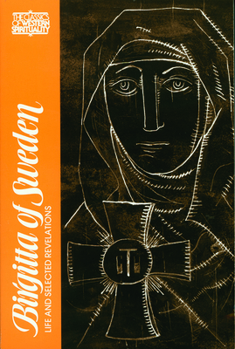Birgitta of Sweden: Life and Selected Writings
Select Format
Select Condition 
Book Overview
...a milestone in American religious publishing. The Catholic World. In one series, the original writings of the universally acknowledged teachers of the Catholic, Protestant, Eastern Orthodox, Jewish and Islamic traditions have been critically selected, translated and introduced by internationally recognized scholars and spiritual leaders. Birgitta of Sweden-Life and Selected writings edited, with a preface by Marguerite Tjader Harris translation and notes by Albert Ryle Kezel introduction by Tore Nyberg I am a sinner unworthy to say such things; nevertheless, know that Jesus Christ appeared to me at prayer. Birgitta of Sweden (c. 1303-1373) The Catholic history of Scandinavia is rich in its legacy of saints and blesseds: Canute, Eric, Hallvard, Henry, Olaf, Sigfrid, Thorlac and many others. One Swedish saint has achieved worldwide fame: Birgitta Birgersdotter, born into wealth and aristocracy, a happily married mother, a religious foundress, a mystical visionary and the fines Scandinavian writer of the Middle Ages. Like Joan of Arc, Birgitta experienced a repeated and insistent visionary call to public action. Her task was to reawaken the Church's attention to the essential things of God; and, in her vividly colorful writings, she has left to the world an exemplary record of her own perseverance in prayer. Knut Westman, a major authority on St. Birgitta, says of her: "Birgitta is of another kind of religion: personal, vocational, mystical, recognized by its strong ethical attitude, its visions of God's work through history, and the consciousness of being called to task...Such a life cannot be explained as a product of known factors." Contained in this volume are four key documents of Birgittine literature: the eyewitness Life of Blessed Birgitta, the complete Fifth and Seventh books of her Revelations, and her Four Prayers. Of the present volume, Birger Bergh, prominent Birgittine textual critic, writes: "This translation, done by a translator with a sensitivity of style and with genuine understanding of the Birgittine world, gives a perfect picture of the Latin original and its fluent diction." +
Format:Paperback
Language:English
ISBN:0809131390
ISBN13:9780809131396
Release Date:January 1989
Publisher:Paulist Press
Length:368 Pages
Weight:1.12 lbs.
Dimensions:1.0" x 6.0" x 9.0"
Customer Reviews
2 ratings
A must read for all Christians
Published by Thriftbooks.com User , 15 years ago
Birgitta of Sweden is a close look at her relationship with God through Christ. Her dialog with Jesus, in great detail here, is an inspiration to Saint buffs everywhere and Christians in all denominations.
More helpful for history than religious inspiration
Published by Thriftbooks.com User , 19 years ago
Birgitta of Sweden, also sometimes referred to as St. Brigid of Sweden, was a Christian mystic who lived during 1303-1373. I was interested in learning more about her, because my Grandmother found Brigitta's 15 Prayers of St.Brigid, which meditate on the Passion (and which can be found in the Pieta Prayer book, published by MLOR Corporationa) particularly edifying. Birgitta is also known for her endeavors to reform the Church during the time when the Pope often preferred the fun of Paris to the duty of Rome. She is an unusual type for a medieval mystic, because unlike many mystics, she lived a large part of her life in the world and raised a family. After the death of her husband, she supposedly received visions from Jesus and his mother, and later founded a religous order. She was related to the Swedish royal family and offered advice to many members of nobility and the Church hierarchy. I was disappointed that the book did not discuss the bacground of her life more. There is a lengthy introduction, but most of it seemed to be concerned with semantics. I found it ironic that the dryest part of the book, was the most modern information provided. Apparently her writings, which were conducted to explain her visions, were compiled into seven or eight books (there were two approaches in their compilation). The translation by Marguerite Harris only includes Book 5 and Book 7. I did not realize that this book presented and incomplete collection until I received it. Hwoever, I have not seen a complete collection of her work elsewhere in English. The two books vary greatly in their style and approach. Book 5 is a written in a dialogue format. As Brigitta travels on horseback, she begins to pray and in her prayer she sees a vsision. The vision is of a figure asking questions, and the person receiving answers from God. The figure repsresnts a monk, but his order is not named. Each chapter in Book 5 is a series of straight questions, followed by straight anwsers. The questions are mostly philosophical in nature, although some teach basic seeds for Christian theology like the questions that pertain to "why should I not do what my body wants," "why do good people suffer." Some of the questions are more speculative and less likely to be a concern of modern theology, "like why did Jesus wait nine months to be born." The second book, Book 7, is a series of different visions that Birgitta had over a longer period of time. Book 7 encompasses her journey form Sweden to Rome and to the Holy Land and back to Rome. Many of her visions in it concern responses to people who sought her advice; members of nobility, Franciscans who were having trouble with members of their order, and religious leaders. Some one familiar with the members of European nobility might enjoy this aspect of the book because of the details it gives about personal problems that real leaders of the time were having. Unlike other mystics, and even herself in Book 5, in Book 7 she names the nam






